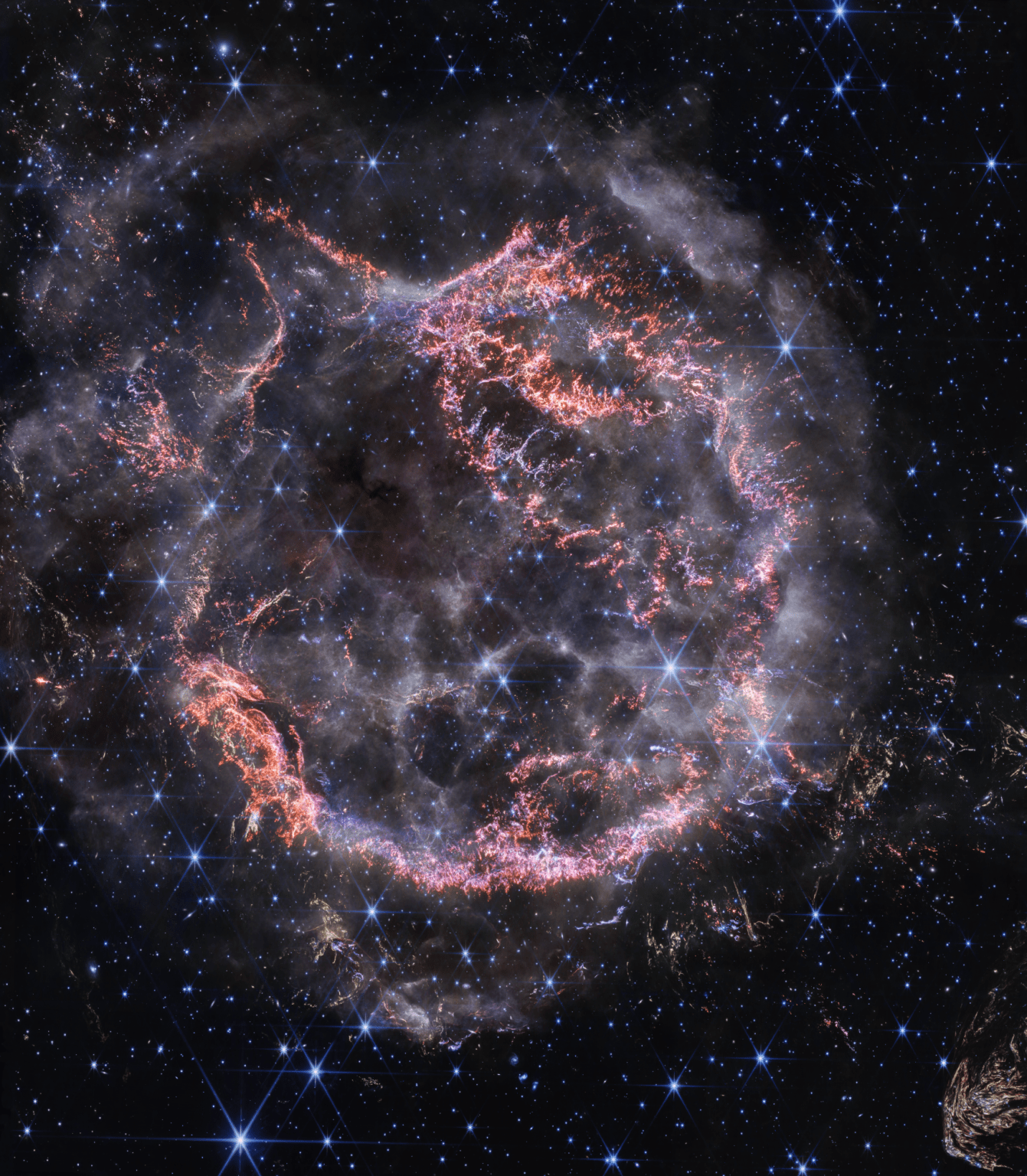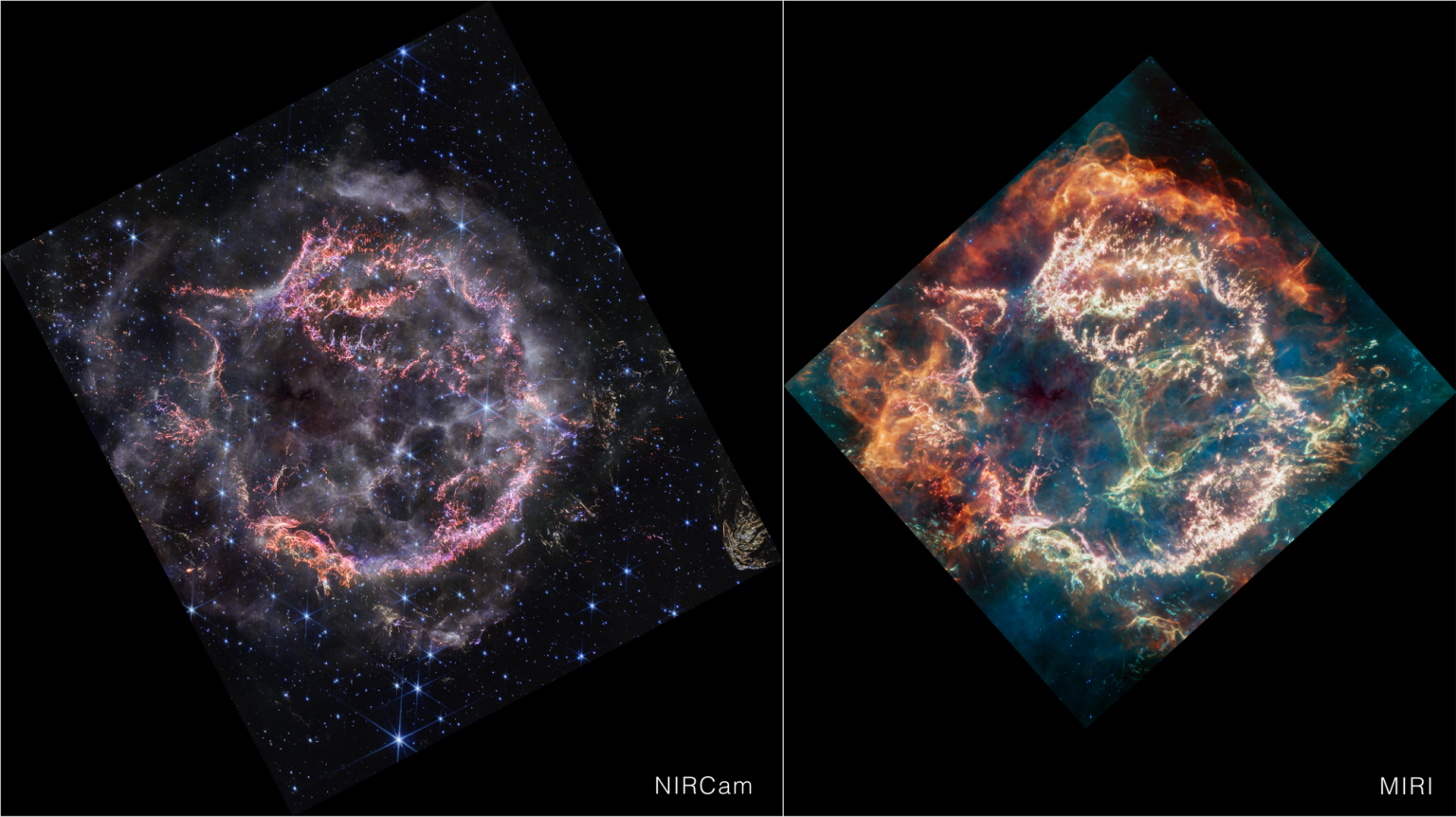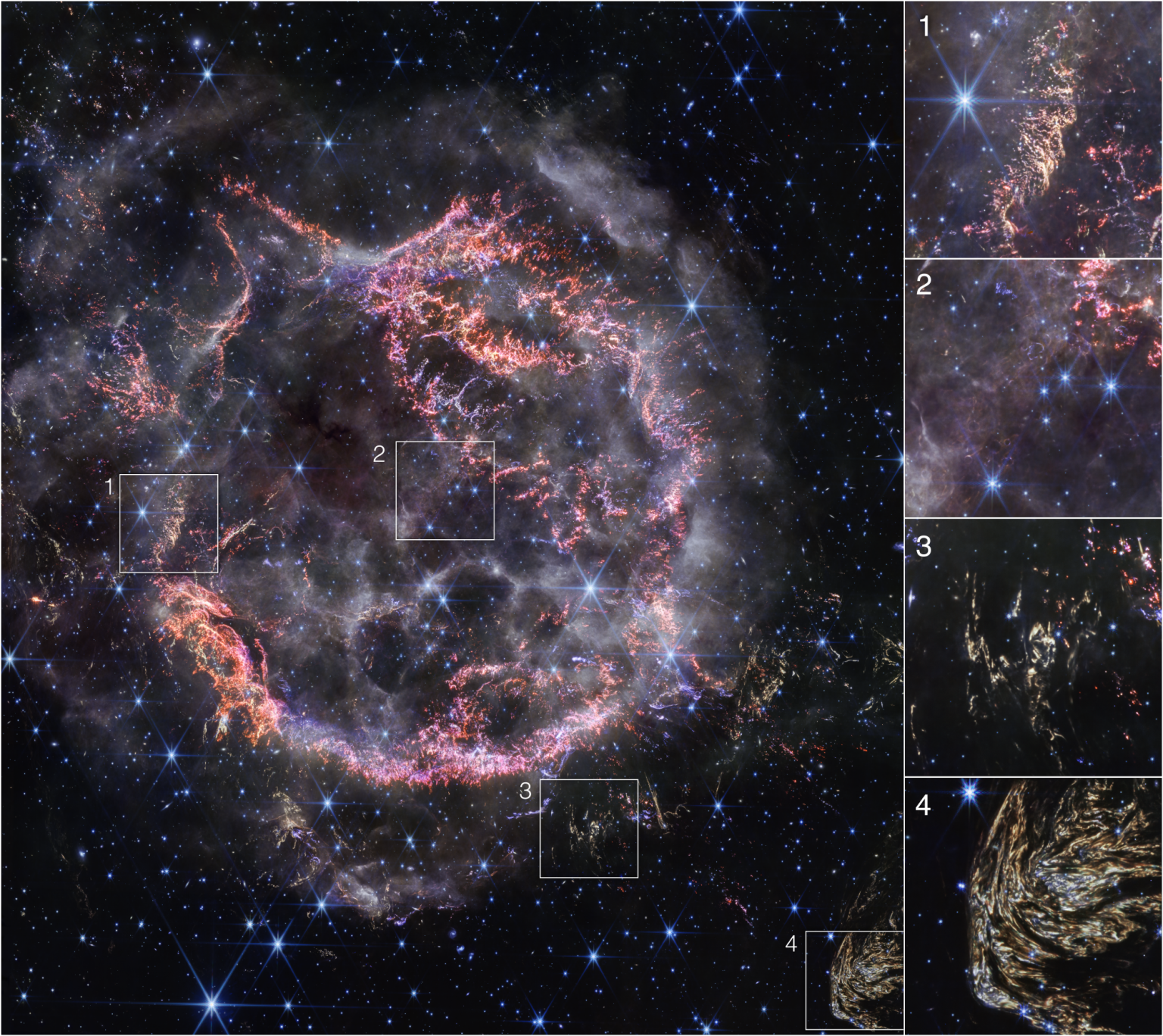
Posted on 12/12/2023 1:06:36 PM PST by Red Badger
Mysterious features hide in near-infrared light
Like a shiny, round ornament ready to be placed in the perfect spot on a holiday tree, supernova remnant Cassiopeia A (Cas A) gleams in a new image from NASA’s James Webb Space Telescope. As part of the 2023 Holidays at the White House, First Lady of the United States Dr. Jill Biden debuted the first-ever White House Advent Calendar. To showcase the “Magic, Wonder, and Joy” of the holiday season, Dr. Biden and NASA are celebrating with this new image from Webb.
While all is bright, this scene is no proverbial silent night. Webb’s NIRCam (Near-Infrared Camera) view of Cas A displays this stellar explosion at a resolution previously unreachable at these wavelengths. This high-resolution look unveils intricate details of the expanding shell of material slamming into the gas shed by the star before it exploded.
Cas A is one of the most well-studied supernova remnants in all of the cosmos. Over the years, ground-based and space-based observatories, including NASA’s Chandra X-Ray Observatory, Hubble Space Telescope, and retired Spitzer Space Telescope have assembled a multiwavelength picture of the object’s remnant.
However, astronomers have now entered a new era in the study of Cas A. In April 2023, Webb’s MIRI (Mid-Infrared Instrument) started this chapter, revealing new and unexpected features within the inner shell of the supernova remnant. Many of those features are invisible in the new NIRCam image, and astronomers are investigating why.

Image: Cassiopeia A (NIRCam)
Cassiopeia A, a circular-shaped cloud of gas and dust with complex structure. The inner shell is made of bright pink and orange filaments studded with clumps and knots that look like tiny pieces of shattered glass. Around the exterior of the inner shell, particularly at the upper right, there are curtains of wispy gas that look like campfire smoke. The white smoke-like material also appears to fill the cavity of the inner shell, featuring structures shaped like large bubbles. Around and within the nebula, there are various stars seen as points of blue and white light. Outside the nebula, there are also clumps of yellow dust, with a particularly large clump at the bottom right corner that appears to have very detailed striations. NASA’s James Webb Space Telescope’s new view of Cassiopeia A (Cas A) in near-infrared light is giving astronomers hints at the dynamical processes occurring within the supernova remnant. Tiny clumps represented in bright pink and orange make up the supernova’s inner shell, and are comprised of sulfur, oxygen, argon, and neon from the star itself. A large, striated blob at the bottom right corner of the image, nicknamed Baby Cas A, is one of the few light echoes visible NIRCam’s field of view. In this image, red, green, and blue were assigned to Webb’s NIRCam data at 4.4, 3.56, and 1.62 microns (F444W, F356W, and F162M, respectively).
NASA, ESA, CSA, STScI, D. Milisavljevic (Purdue University), T. Temim (Princeton University), I. De Looze (University of Gent)
‘Like Shards of Glass’
Infrared light is invisible to our eyes, so image processors and scientists translate these wavelengths of light to visible colors. In this newest image of Cas A, colors were assigned to different filters from NIRCam, and each of those colors hints at different activity occurring within the object.
At first glance, the NIRCam image may appear less colorful than the MIRI image. However, this simply comes down to the wavelengths in which the material from the object is emitting its light.
The most noticeable colors in Webb’s newest image are clumps represented in bright orange and light pink that make up the inner shell of the supernova remnant. Webb’s razor-sharp view can detect the tiniest knots of gas, comprised of sulfur, oxygen, argon, and neon from the star itself. Embedded in this gas is a mixture of dust and molecules, which will eventually become components of new stars and planetary systems. Some filaments of debris are too tiny to be resolved by even Webb, meaning they are comparable to or less than 10 billion miles across (around 100 astronomical units). In comparison, the entirety of Cas A spans 10 light-years across, or 60 trillion miles.
“With NIRCam’s resolution, we can now see how the dying star absolutely shattered when it exploded, leaving filaments akin to tiny shards of glass behind,” said Danny Milisavljevic of Purdue University, who leads the research team. “It’s really unbelievable after all these years studying Cas A to now resolve those details, which are providing us with transformational insight into how this star exploded.”

Image: Cassiopeia A NIRCam/MIRI
A comparison between two images, one on the left (labeled NIRCam), and on the right (labeled MIRI), separated by a white line. Both are a square image rotated clockwise about 45 degrees, with solid black in the top left, top right, bottom left, and bottom right corners. On the left, the image is a circular-shaped cloud of gas and dust with complex structure. The inner shell is made of bright pink and orange filaments that look like tiny pieces of shattered glass. Around the exterior of the inner shell are curtains of wispy gas that look like campfire smoke. The white smoke-like material also fills the cavity of the inner shell, with structures shaped like large bubbles. Outside the nebula, there are also clumps of yellow dust. On the right, is the same nebula in different light. The curtains of material outside the inner shell glow orange instead of white. The inner shell looks more mottled, and is a muted pink. At center right, a greenish loop extends from the right side of the ring into the central cavity.
This image provides a side-by-side comparison of supernova remnant Cassiopeia A (Cas A) as captured by NASA’s James Webb Space Telescope’s NIRCam (Near-Infrared Camera) and MIRI (Mid-Infrared Instrument). Objects in space reveal different aspects of their composition and behavior at different wavelengths. The outskirts of Cas A’s main inner shell, which appeared as a deep orange and red in the MIRI image, look like smoke from a campfire in the NIRCam image. The dust in the circumstellar material being slammed into by the shockwave is too cool to be detected directly at near-infrared wavelengths, but lights up in the mid-infrared. Also not seen in the near-infrared view is the loop of green light in the central cavity of Cas A that glows in mid-infrared, nicknamed the Green Monster by the research team.
NASA, ESA, CSA, STScI, D. Milisavljevic (Purdue University), T. Temim (Princeton University), I. De Looze (University of Gent)
Hidden Green Monster
When comparing Webb’s new near-infrared view of Cas A with the mid-infrared view, its inner cavity and outermost shell are curiously devoid of color.
The outskirts of the main inner shell, which appeared as a deep orange and red in the MIRI image, now look like smoke from a campfire. This marks where the supernova blast wave is ramming into surrounding circumstellar material. The dust in the circumstellar material is too cool to be detected directly at near-infrared wavelengths, but lights up in the mid-infrared.
Researchers say the white color is light from synchrotron radiation, which is emitted across the electromagnetic spectrum, including the near-infrared. It’s generated by charged particles traveling at extremely high speeds spiraling around magnetic field lines. Synchrotron radiation is also visible in the bubble-like shells in the lower half of the inner cavity.
Also not seen in the near-infrared view is the loop of green light in the central cavity of Cas A that glowed in mid-infrared, nicknamed the Green Monster by the research team. This feature was described as “challenging to understand” by researchers at the time of their first look.
While the ‘green’ of the Green Monster is not visible in NIRCam, what’s left over in the near-infrared in that region can provide insight into the mysterious feature. The circular holes visible in the MIRI image are faintly outlined in white and purple emission in the NIRCam image – this represents ionized gas. Researchers believe this is due to the supernova debris pushing through and sculpting gas left behind by the star before it exploded.

Image: Cassiopeia A Features
The image is split into 5 boxes. A large image at the left-hand side takes up most of the image. There are four images along the right-hand side in a column, labeled 1, 2, 3, and 4. The 4 images in the column are zoomed-in areas of the larger square image on the left. The image on the left has a circular-shaped cloud of gas and dust with complex structure, with an inner shell of bright pink and orange filaments that look like tiny pieces of shattered glass. A zoom-in of this material appears in the box labeled 1. Around the exterior of the inner shell in the main image there are wispy curtains of gas that look like campfire smoke. Within the cavity of the inner shell, there are small circular bubbles outlined in white. Box 2 is a zoom-in on these circles. Scattered outside the nebula in the main image, there are also clumps of yellow dust. Boxes 3 and 4 are zoomed-in areas of these clumps. Box 4 highlights a particularly large clump at the bottom right of the main image that is detailed and striated.
This image highlights several interesting features of supernova remnant Cassiopeia A as seen with Webb’s NIRCam (Near-Infrared Camera): NIRCam’s exquisite resolution is able to detect tiny knots of gas, comprised of sulfur, oxygen, argon, and neon from the star itself; Circular holes visible in the MIRI image within the Green Monster are faintly outlined in white and purple emission in the NIRCam image; An example of a light echo – when light from the star’s long-ago explosion has reached, and is warming, distant dust, which is glowing as it cools down; A particularly intricate and large light echo, nicknamed Baby Cas A by researchers.
NASA, ESA, CSA, STScI, D. Milisavljevic (Purdue University), T. Temim (Princeton University), I. De Looze (University of Gent).
Baby Cas A
Researchers were also absolutely stunned by one fascinating feature at the bottom right corner of NIRCam’s field of view. They’re calling that large, striated blob Baby Cas A – because it appears like an offspring of the main supernova.
This is a light echo, where light from the star’s long-ago explosion has reached and is warming distant dust, which is glowing as it cools down. The intricacy of the dust pattern, and Baby Cas A’s apparent proximity to Cas A itself, are particularly intriguing to researchers. In actuality, Baby Cas A is located about 170 light-years behind the supernova remnant.
There are also several other, smaller light echoes scattered throughout Webb’s new portrait.
The Cas A supernova remnant is located 11,000 light-years away in the constellation Cassiopeia. It’s estimated to have exploded about 340 years ago from our point of view.
The James Webb Space Telescope is the world’s premier space science observatory. Webb is solving mysteries in our solar system, looking beyond to distant worlds around other stars, and probing the mysterious structures and origins of our universe and our place in it. Webb is an international program led by NASA with its partners, ESA (European Space Agency) and the Canadian Space Agency.
WEBB Ping!...............
Impressive and beautiful.

Indeed. Webb imagery is amazing, both for its detail and the things revealed in the Infrared (where all the fun is). Even a scientist should enjoy a “Bill & Ted” moment with this stuff, before digging into the data.
So, it was an EV star? ;-P
I can never wrap my mind and imagination around the distances—60 Trillion miles across and nothing more than a spec in the sky.
Stunning!
Yes, but it’s just twice the size of our national debt.................🤔🤦♂️
it’s all AI doing that makes it seem artistic... in reality it is just a ball of burning gas...
or a hunka hunka burning lava.
From Brave AI:
As of September 2023, the U.S. national debt stands at just over $33 trillion, which is equal to debt held by the public plus debt held by federal trust funds and other government accounts. Debt-to-GDP is a useful metric for analyzing the debt over long time spans, as it puts the debt into relative terms by comparing it against the size of the national economy.
What if it was the results of a civilization that had finally achieved fusion?.................
Pretty cool but where are the pic’s of advanced civilizations we were promised if only a few billion more could be budgeted?
That was it.
They finally achieved nuclear fusion................
could be... but in the end, it all comes back to ashes to ashes.
Immense isn’t a word big enough to describe it and the surrounding universe.
AMAZING!
Hmmm...
Almost seems to me that the WH perverts are seizing on this for peculiar reasons...
Just WOW
MIRI huh? Clearly (or clirly) there are Star Trek fans at NASA.
Disclaimer: Opinions posted on Free Republic are those of the individual posters and do not necessarily represent the opinion of Free Republic or its management. All materials posted herein are protected by copyright law and the exemption for fair use of copyrighted works.